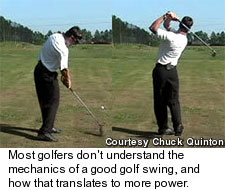The primacy of the perfect pivot
 This week I'm in Pennsylvania working with a couple of our players on the Hooters Tour. While this certainly isn't as glamorous as the PGA Tour, these players are nonetheless playing for money, living their dream and pursuing the PGA Tour.
This week I'm in Pennsylvania working with a couple of our players on the Hooters Tour. While this certainly isn't as glamorous as the PGA Tour, these players are nonetheless playing for money, living their dream and pursuing the PGA Tour.
While there is certainly a world filled with these tours and players, they all have the same goals in mind: to be the best they can be.
They all work diligently on their short game, ball striking, mental game, and getting their set make-up just right as well as keeping their bodies in shape for what is a long season. Strength and flexibility can mean the difference in making the "big show" (Read: PGA Tour) or staying in the "minor leagues." With this in mind these players all have something that is inherent to all golfers: the search for perfection!
While having perfect mechanics isn't a guarantee that one will make it on Tour, perfect mechanics do produce perfect shots.
One thing that I see a lot are players that really don't understand how the body, arms, and hands really work in a golf swing. If the body out races the arms then a push shot is likely and if the arms and hands out race the body then shots that are pulled will be the norm. The hands can make up for a faulty pivot motion to a certain extent but why make that adjustment if you don't have to. There is a proper sequence that is based upon physics that you can rely on.
The golf stroke is a series of events that take place which produces a "lagging" of components. Let me explain. Think of the golf stroke as a gear train that starts from the ground up. In the start down, the hips rotate back toward the target while the hands and arms remain at the top of the backstroke. This applies pressure from the upper left arm to the chest - sort of gluing it to the chest. The trunk now follows with the right shoulder moving down plane and the arms going along for the ride.
So now you have the gear train effect, hips pull the trunk, trunk pulls the arms, arms pull the hands and club. This continues until the ball is struck and the player gets to what we refer to as follow through - the place in the swing that both arms are straight. From there all of the components are basically released and have come into alignment with each other.
At our Medicus Golf Institute Golf schools we train players on the physics of rotation and the geometry of the circle. Now that may sound complicated but it really isn't once we put into lay terms and actions.
To really store up power try using this procedure above and you will see an increase not only in power but in accuracy!
May 11, 2007
Chuck Evans, G.S.E.D., a Golf Magazine Top 100 Teacher, is one of only 31 golf instructors worldwide designated to hold a doctorate in golf stroke engineering. He is executive director of instruction for the Medicus Golf Institute and has served as director of schools for the PGA Tour Golf Academy, and as director of instruction for the United States Golf Institute. He is also the author of "How To Build Your Golf Swing."
 By
By